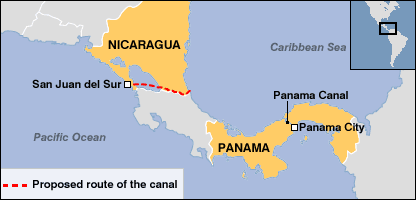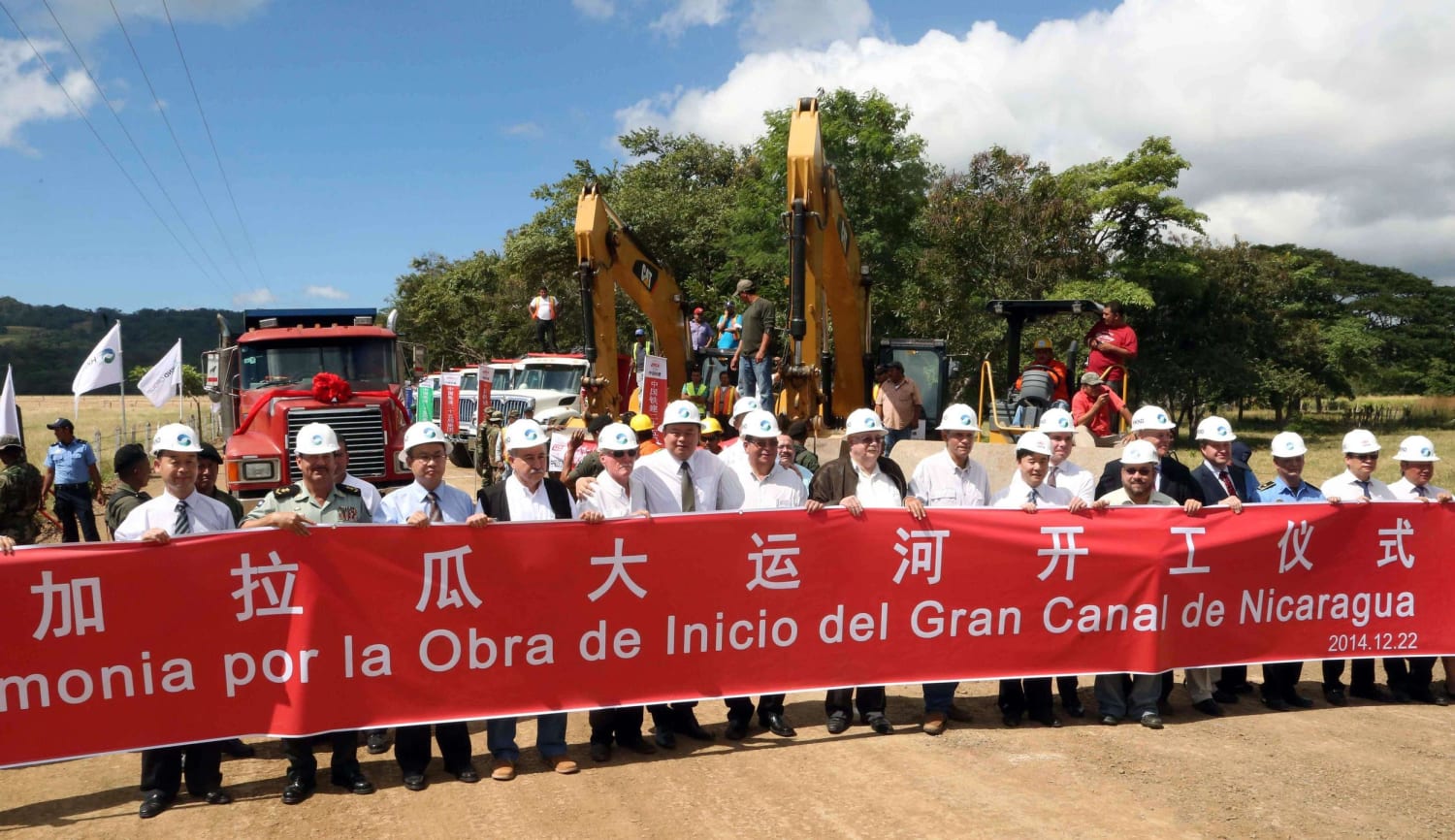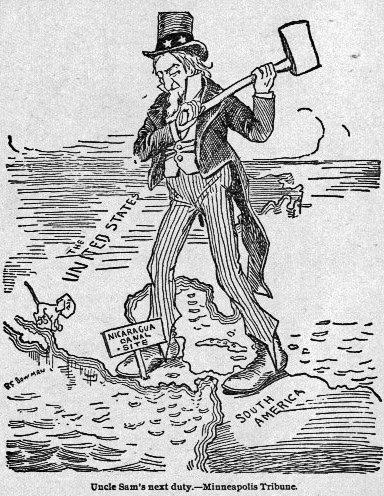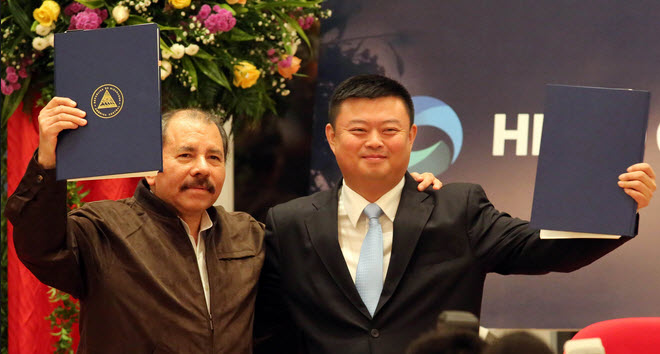This is a three part story carried by McClatchy News and written by some great writers. It is an in depth study of the current events and how this project though cloaked in secrecy may indeed happen and how it will affect thousands of people who will be displaced by the largest earth moving project ever in the world.
First, here is Tim Johnson’s article. Colossal. Mammoth. Vast.
There’s almost no other way to describe the proposal to build a 170-mile, inter-oceanic canal across Nicaragua, and while the plan has been greeted with widespread skepticism, powerful global forces may also coax the project forward.
Those forces include the rising economic might of China, the suspected backer of the proposal, and the emergence of ever-growing number of mega-ships that can’t pass through an expanded Panama Canal but could transit the one proposed for Nicaragua.

Already, preliminary work has begun, at a cost to date of hundreds of millions of dollars. Land has been surveyed, routes identified, negotiations begun with landholders. Yet secrecy still cloaks the project, whose ramifications are vast. Tens of thousands of Nicaraguans would be displaced and hundreds of square miles of land would be given over to the Chinese company that holds the concession to build the canal.
Other ramifications can only be guessed at: The impact the canal would have on Nicaragua’s environment has yet to be made public. Also uncalculated: the ramifications on world trade that would come from the inter-ocean passage of ships so large that most U.S. ports can’t handle them.
Another looming unknown: how the global balance might change with a Chinese-built and -financed canal dug across an isthmus that has been a nearly exclusive American zone for 200 years.

Whatever the long-term cost, and if its backers conjure up the financing – still a big if – the creation of what would be the world’s biggest canal is without doubt the largest earth-moving project of the modern era.
An army of 50,000 workers would be required to gash a 90-foot-deep ditch across Nicaragua. Plans call for more than 2,000 excavators and heavy earth movers – some with wheels bigger than the tallest NBA player – to gouge, claw and chew their way across Nicaragua, moving 5 billion cubic meters of dirt, rock and sludge.
“There’s been no civil engineering project of this magnitude – ever,” said Bill Wild, the chief project adviser to HKND Group, the Hong Kong-based firm that has won a 50-year concession to build and operate the canal.

Perhaps appropriately, as the Chinese dragon enters Central America, one has to look to China’s Three Gorges Dam, the world’s largest hydropower project, finished in 2006, to find anything close to equal. That dam, which spans the Yangtze River and displaced well over 1.1 million Chinese upriver along a massive reservoir, used more than double the concrete that would go into the Nicaraguan canal.
“But we are 50 times the size of Three Gorges in terms of earthworks,” Wild said. “Three Gorges is about 100 million (cubic meters of excavated material). We intend to move the best part of 100 million per month.”
Nothing built in the United States recently remotely comes close, neither the new San Francisco-Oakland Bay Bridge nor Boston’s Big Dig.
Just how much earth has to be moved?
– The estimated 5 billion cubic meters of excavated material would fill 1,698 venues the size of Cowboys Stadium in Arlington, Texas.
– It would bury San Francisco (46.38 square miles) to a height of 136 feet.
– It would cover all of Disney World (43 square miles) to a depth of 147 feet, leaving only the tallest spire of Cinderella’s Castle exposed.
The canal company won’t need just fleets of heavy machinery to excavate and haul away the material. The battalions of workers would need 400,000 tons of explosives to blast through rock, and 1.5 billion gallons of diesel and bunker fuel to power the heavy machinery.

Enter the dragon
Nicaraguans have dreamed of a canal for generations. So have the Americans, since the beginning of the 1849 California Gold Rush, when tens of thousands of Americans took steamships to the mouth of the San Juan River on Nicaragua’s southeast border. They traveled up the river, across Lake Nicaragua and on to the Pacific coast to board vessels for California.
Near the end of the century, American engineers looked seriously at building a canal, taking water measurements along the river and in shallow Lake Nicaragua. But a postage stamp picturing an erupting Momotombo volcano – one of Nicaragua’s 19 active volcanoes – scared U.S. lawmakers and persuaded them to build a canal in Panama instead.

Nicaragua’s dream never died, however. A handful of other proposals arose over the decades. But it wasn’t until an opera singer made a fateful trip to Beijing earlier this decade that hopes rose anew. The opera singer was Laureano Ortega, one of the sons of Nicaraguan President Daniel Ortega, a former guerrilla commander whose most recent turn in power has found him mixing populist, anti-imperialist slogans with pro-business policies.
The younger Ortega, who studied at the Giuseppe Verdi Conservatory of Music in Milan, likes to sing parts in Puccini and Verdi operas. But he was wearing a different hat on that trip to Beijing. He was traveling as an adviser to ProNicaragua, an official investment promotion agency.
“He talked about the possibility of the canal, and they were so interested,” said Manuel Coronel Kautz, the chief of Nicaragua’s Canal Authority. Chinese officials sent Laureano Ortega to see the minister of infrastructure and authorities at the Bank of China, where he was told that private-sector tycoons would take the initiative.
They handed Laureano Ortega a list. On the list was the name of Wang Jing, a billionaire telecom tycoon with powerful ties within China’s long-ruling Communist Party and reputed ties to the People’s Liberation Army. A meeting was arranged.
Thus began negotiations that culminated in June 2013, when the Ortega-controlled National Assembly approved a 50-year concession to Wang’s HKND Group to build and operate a trans-oceanic canal, two ports, a free-trade zone, an airport, tourism resorts and other projects.
The concession, which can be renewed for another half-century, gives Nicaragua the right to 1 percent ownership the year the canal comes into operation, rising by 1 percent a year until it owns half the project in 50 years.
China’s government says it has nothing to do with the project – and technically that’s correct. But some of China’s biggest state-owned enterprises are on board as contractors, and they are subservient to the Chinese Communist Party.

Ortega in command
Daniel Ortega and his Sandinista Front are riding high with all the talk about the coming boom. Fifty-three percent of Nicaraguans support Ortega, making him one of the more popular presidents in Latin America, according to a CID-Gallup poll released in late May.
Nearly all levers of power are at his disposal. Ortega controls the Congress, the electoral council, the Supreme Court, the army, the police and much of the media. The atmosphere for opponents is chilly, especially for those who ask questions about the canal – and don’t get answers.
Octogenarian poet Ernesto Cardenal, a Sandinista culture minister in the 1980s and a bitter opponent of Ortega today, calls the canal proposal “a monstrosity.”
Business owners are wary about land expropriations and environmental damage that may occur with canal construction. Some also recognize how the canal could transform the nation.
“There’s going to be more benefit to Nicaragua (by) building the canal than not building the canal,” said Michael Healy Lacayo, chief of the Union of Agricultural Producers of Nicaragua, the nation’s biggest farm group. “Right now, we have steady growth of 4 or 4.5 percent a year. With the canal built, we should be growing around 9 or 10 percent a year.”
“You must realize that Nicaragua has been considered the second poorest country in Latin America and the Caribbean after Haiti,” said Telémaco Talavera Siles, a university rector who is the canal project’s official spokesman.
“We have to make a leap. And for this leap, we need grand, transformative projects,” Talavera added.
The canal and its affiliated enterprises, once in full operation, would employ 200,000 people in direct and indirect jobs, Talavera said. The project foresees a massive free-trade zone where some 5,000 businesses would have operations in manufacturing, logistics and shipping, employing 113,000 people.
With all that activity, the size of Nicaragua’s economy would double to about $25 billion a year, he added.
Digging the canal would leave scars, though. Under the concession, the Hong Kong company would have rights to 633 square miles of land for the canal, the associated projects and an artificial lake, although a spokeswoman, Liliana Li, said it is likely that only 424 square miles would be used. Even that is a big chunk of land, equivalent to nearly 19 times the area of New York City’s Manhattan.
Scientists say not enough study has been done on the canal’s consequences.
“If large ships pass through Lake Nicaragua, what impact would it have?” asked Jorge Huete-Pérez, a molecular biologist and vice chair of the Nicaraguan Academy of Science. “Will the canal inhibit the movement of endangered mammals?”
Huete-Pérez noted that the canal’s proposed route from Brito on the Pacific coast to the Punta Gorda River delta on the Caribbean side encompasses “a hotspot for global biodiversity.” Lake Nicaragua, in particular, holds a unique place in freshwater fish evolution.
The lake used to be the freshwater home to bull sharks that swam up the San Juan River, and to prehistoric-looking massive sawfish. Both have since vanished.
Coronel, the spry 82-year-old canal authority chief who grew up near the river’s confluence with the lake, lurched in his chair when asked if he’d seen sharks as a youth.
“Come on!” he said. “We used to go fish shark (and catch) three, four, five a day during certain seasons.”
Sawfish pulled from the lake could measure 7 to 10 feet long, he said, and the jungles and wetlands held all manner of jaguar, tapir, armadillo, anaconda and giant anteaters.

Settlers and colonists have hacked down much of that forest to build cattle ranches. Nicaragua is believed to be losing 270 square miles of woodland a year.
So which is worse, the helter-skelter, slow-motion destruction of settlers or the gashing of a massive canal across the isthmus? The canal company says the answer is in a massive study of the environmental and social impact of the project that it turned over to Nicaragua in a May 31 ceremony. The study, which comprises 14 volumes containing 11,000 pages of text and diagrams, has not yet been made public.
A trip along much of the proposed canal route revealed that stands of forest are now rare. In much of southeast Nicaragua, chainsaws do the talking, even in the Cerro Silva and Punta Gorda nature reserves.
Activity would become frenetic as the canal company builds nine workers’ camps, each housing 5,400 or so employees, along the proposed canal route. The camps would be closed to outsiders. The company plans rigorous drug and alcohol testing for all employees at the camps, likely crucibles of East meets West.
Some 12,500 Chinese laborers would toil alongside three times as many workers from Nicaragua and other parts of the world. The company says it will “prohibit informal trade, squatter camps and prostitution within the worker camps,” but Coronel said brothels would flourish nearby.
“Where Nicaraguans work, everything happens. . . . Prostitution will be rampant. I know that perfectly. I used to work in a sugar mill, and they used to pay every 15 days, 2,000 people. And there were two or three special places,” he said.
Shifts would last 12 hours, and workers would get breaks after working two to six weeks straight. Excavation would be never-ending. The mountainous piles of excavated material would be placed on 35 spoil dumps.
“You can’t just leave it as mountains along the project,” said Wild, the chief adviser, an Australian. So the workers would heap the material into flat-topped mesas, replace the topsoil and create new, slightly sloping farmland, he said.
By creating 69 square miles of landfill and turning it into farmland near the canal route, Wild said, forest would be lost. But HKND Group has issued a public commitment that the net environmental impact of the canal would be positive. Wild said it plans “a massive amount of reforestation generally throughout the corridor of the canal.”
Workers are already building access roads and drilling new wells, even before Nicaragua has signed off on the environmental impact study. Actual digging is to commence by the end of the year, officials said.
Speed and secrecy have become hallmarks of the project.
Wang has pledged to finish the canal by 2020.
“Wang Jing is in a hurry,” said Coronel, the canal authority chief, noting that consultants had suggested eight to 10 years to complete the project.
“When Wang Jing came and I told him 10 years, he got up and he told me, ‘No! Ten years! That can’t be,’” Coronel recalled. “So I asked him, how long? He tells me, ‘Five.’ So I got up and said, ‘No! It can’t be.’ So we sit down and he tells me, ‘Ah, you don’t know China. . . . You have a technical problem? I’ll bring 1,500 engineers tomorrow.’”
Few details have emerged of how the company plans to settle with people who must be relocated. HKND spokeswoman Li said compensation would be reasonable.
“For all the residents in the construction area, with or without land title, the land issue will be solved in a fair and satisfactory way,” Li said in an email.
Forty-seven protest marches against the project have unfolded along the route. A few have turned violent, as police have cracked down and left injuries. The biggest of the marches occurred June 13 and drew more than 10,000 protesters in the city of Juigalpa.
Some opponents of the canal voice fear.
“I know my telephone is tapped,” said Franklin Briceño Martínez, an environmental activist in San Miguelito, on the eastern shore of Lake Nicaragua.
Briceño spent 10 years in the Sandinista Popular Army and still considers himself a Sandinista, the revolutionary party that Ortega led when he overthrew a military dictatorship and then served his first term as Nicaragua’s president. But Briceño doesn’t like Ortega now and considers the canal a beachhead for Chinese intervention, replacing the U.S. intervention feared for so many decades.
“We are facing a new colonization by China. China won’t be here just for the canal,” Briceño said. “We don’t want war. But we also don’t want to become slaves of an Asian culture.”
Talavera, the canal spokesman, dismissed worries about Chinese influence. He recalled the U.S. role in building and administering the Panama Canal for nearly a century, keeping the Panama Canal Zone largely off limits to Panamanians.
“Panamanians needed a passport or special document to enter,” Talavera said. “The military forces there were from the U.S. Southern Command. The laws in effect were U.S. laws. . . . Panamanians had no say in any decisions there.”
In contrast, he said, “national police will provide security here, not Chinese police. Those who will protect the sovereignty are not (members of) the Russian army as has been said. It’s the Nicaraguan army. And the laws here are Nicaraguan. Nicaraguans will be free to go anywhere.”

International challenge to America?
The U.S. government has remained largely silent about the project, although the U.S. Embassy in Managua issued a statement in January calling for the Ortega government to offer greater transparency about the canal.
Henry Kissinger, an elder U.S. statesman, seemed to sum up Washington’s attitude in an interview with the Chinese magazine Caixin in late March.
“We are now great countries, we will both operate around the world. We will be in some places side by side, some places not side by side. I don’t think that is the issue, and if China wants to spend resources on building a canal in Nicaragua and doesn’t make it a naval base, which is inconceivable, why should that concern me?” Kissinger told the magazine.
Since the debut of mega container ships two years ago on the world’s oceans, the trend is sharply upward. Each of the behemoths can carry more than 18,000 20-foot shipping containers. So far this year, eight maritime lines have placed orders for 39 of the mega-ships, the Journal of Commerce reported this month.
Mystery still surrounds how Wang plans to raise the money to finance canal construction. With a wealth estimated by Forbes magazine at around $7.7 billion, Wang would have to raise money elsewhere. His company has said it will place a listing on a stock exchange. It hasn’t said where the listing will occur.
A top adviser to President Ortega, Bayardo Arce, suggested May 25 to reporters that the project was at a temporary lull. Sounding slightly miffed, he said obliquely that “there is still no cash deposited” for the construction. He did not elaborate.
Lawyers at the Chicago firm of Kirkland & Ellis, retained by Wang, are raising red flags about property issues along the canal route, Coronel said.
“No one is clear owner of much of the land that will be affected,” he said. “In the civil registry, there aren’t clear titles.”
Some 15 to 20 government lawyers are rushing to grant provisional land titles to settlers and ranchers, Coronel said. Then negotiation over payment for compensated land can begin. He said the land issue should be cleared up by the final quarter of the year, leading to a stock exchange offering.
“Four, five or 10 Chinese companies will buy up the shares and it’ll be all done,” Coronel said. “Problem solved. If Ali Baba decides to buy, let’s say, a million shares, and then the railway company another million, why not?”
Only then would construction begin in earnest.
Ronald MacLean, a Bolivian politician with a Harvard pedigree who served as the global spokesman for HKND Group until earlier this year, said Nicaragua would be transformed.
“It probably will become the most prosperous country in Central America. And I wish I could do the same for Bolivia,” MacLean said.
“A lot of people in Nicaragua are missing the opportunity to look at this as a great, unique, once-in-a-lifetime opportunity.”
Brittany Peterson of the Washington Bureau contributed to this story, one of several on the proposed Nicaragua canal that were funded in part by a grant from the Pulitzer Center on Crisis Reporting.
Cloaked in secrecy
Details of Nicaragua canal project remain hidden
Ronald McCrae and his wife, Carmela Hodgson, live in the oceanfront village of Bangkukuk. A planned canal would build a massive container port on Bangkukkuk’s shore.
Nicaragua’s Rama Indians face peril from canal and migrants



